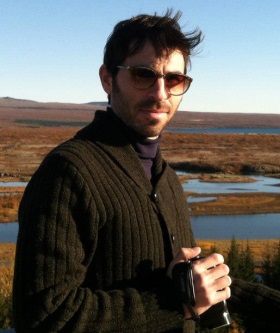 Who: Jonathan Hertzberg is a Brooklyn-based filmmaker who runs the Obscure One-Sheet film blog. His ongoing video series, Dirty Old New York aka Fun City, focuses on films that were shot on location in New York City from the mid-1960s to mid-1980s — a period when filmmakers used the city’s urban decay as a backdrop for stories highlighting its rich cultural landscape. A former feature film programmer for the Chicago International Film Festival, Hertzberg works as a consultant in film sales and distribution, with a focus on foreign and independent markets. His interest in cinematic locations contributed to the creation of his Fun City series, which began with a video on the Dirty Old New York Subway. His subsequent videos have highlighted many other aspects of city life that appear in films of that era. They are presented without voiceover, and utilize the soundtracks and soundscapes of the films themselves. As Hertzberg notes on his blog, “All shots are connected by at least one of the following: location, film, character, actor, signage, recurring object, or recurring motif.” The recurring actors include Joe Spinell, Steve Inwood, Cliff Gorman, Randy Jurgensen and other familiar faces whose lesser-known filmographies Hertzberg regularly delves into on his site. Camera In The Sun spoke with Hertzberg for a September 2013 interview about his Fun City series, Obscure One-Sheet, and various aspects of dirty old New York City.
Who: Jonathan Hertzberg is a Brooklyn-based filmmaker who runs the Obscure One-Sheet film blog. His ongoing video series, Dirty Old New York aka Fun City, focuses on films that were shot on location in New York City from the mid-1960s to mid-1980s — a period when filmmakers used the city’s urban decay as a backdrop for stories highlighting its rich cultural landscape. A former feature film programmer for the Chicago International Film Festival, Hertzberg works as a consultant in film sales and distribution, with a focus on foreign and independent markets. His interest in cinematic locations contributed to the creation of his Fun City series, which began with a video on the Dirty Old New York Subway. His subsequent videos have highlighted many other aspects of city life that appear in films of that era. They are presented without voiceover, and utilize the soundtracks and soundscapes of the films themselves. As Hertzberg notes on his blog, “All shots are connected by at least one of the following: location, film, character, actor, signage, recurring object, or recurring motif.” The recurring actors include Joe Spinell, Steve Inwood, Cliff Gorman, Randy Jurgensen and other familiar faces whose lesser-known filmographies Hertzberg regularly delves into on his site. Camera In The Sun spoke with Hertzberg for a September 2013 interview about his Fun City series, Obscure One-Sheet, and various aspects of dirty old New York City.
Dirty Old New York aka Fun City, Part I from Jonathan Hertzberg on Vimeo.
On his goals for the Fun City series
I guess my mission with them, or one of the missions, is I like calling attention to films that a lot of people might not be aware of, or they might have forgotten. Also, the places that these films show — places that don’t exist anymore, or exist in a very different form. And it’s always exciting when it’s somewhere that you know pretty well on film. I think my videos are valuable in that way, because it 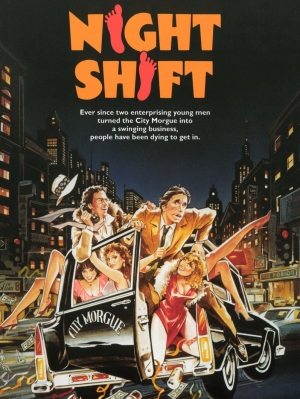 would be great if people wanted to actually go and watch these films themselves. And I haven’t created a master list of all the films included in my videos, which I should probably do. Because people have asked me about that. But it’s cool that a few more people will check out something like Night Shift, which gets a lot of good play on the subway video. I think that’s one of those movies that maybe people don’t know about. You know, people know the Scorsese movies, and they know the Woody Allen movies. So I definitely wanted to get some stuff in there that’s outside of that canon.
would be great if people wanted to actually go and watch these films themselves. And I haven’t created a master list of all the films included in my videos, which I should probably do. Because people have asked me about that. But it’s cool that a few more people will check out something like Night Shift, which gets a lot of good play on the subway video. I think that’s one of those movies that maybe people don’t know about. You know, people know the Scorsese movies, and they know the Woody Allen movies. So I definitely wanted to get some stuff in there that’s outside of that canon.
If I had to pick one film from the “Fun City” period that is both dear to me and woefully under the radar, it’s Arthur Barron’s Jeremy — a very emotionally honest story of first love, starring Robby Benson and Glynnis O’Connor. I think it’s reminiscent of European films that cover the same territory. Except that it’s in English, of course, and uses Mayor John Lindsay’s gritty New York City — aka “Fun City” — as its backdrop. It’s shot on 16mm and blown up to 35mm. But the lo-fi, street-level aesthetic suits the material, and is apt for the city as it appeared then. From the responses I’ve gotten to my pieces on the film and Ms. O’Connor, I can tell you that for people who were coming of age at that time in the early ’70s, both Jeremy and its young stars really struck a chord. Barron won an award at Cannes for “Best First Work” and Benson and O’Connor’s careers as teen favorites flourished throughout the decade. The film wasn’t available on home video until the late ’90s. And since it doesn’t have names that really resonate with current audiences, nor fit into the crime/cop canon, for obvious reasons it was largely forgotten. In high school, I read about it in Danny Peary’s invaluable Guide For The Film Fanatic, and finally saw it years later when the VHS was released. It quickly became a favorite film of mine. I’m always trying to get it out there for others to discover. Hence its prominent placement in the Dirty Old New York aka Fun City series.
On some of the key recurring actors in the Fun City era
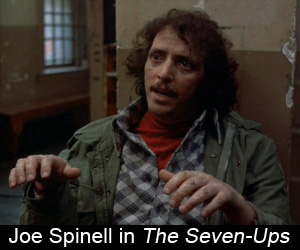 Joe Spinell is obviously one of the more well-known examples. When you watch these movies, suddenly you just start seeing the same faces. A lot of times, they might not even have too many lines. But a lot them fill ethnic roles. In particular, Italian types or Jewish types. Spinell is a great example of that. I’ve thought about doing an honor roll video showing all these actors, because I’m fascinated by those faces — those people you usually don’t know the names of. Like, “Oh, that guy. I know I’ve seen him in something before.” You pull him up on the IMDB, and he’s in every other cop movie. You know, there were just so many movies being shot in the area at that time, and they just kept going to the same well.
Joe Spinell is obviously one of the more well-known examples. When you watch these movies, suddenly you just start seeing the same faces. A lot of times, they might not even have too many lines. But a lot them fill ethnic roles. In particular, Italian types or Jewish types. Spinell is a great example of that. I’ve thought about doing an honor roll video showing all these actors, because I’m fascinated by those faces — those people you usually don’t know the names of. Like, “Oh, that guy. I know I’ve seen him in something before.” You pull him up on the IMDB, and he’s in every other cop movie. You know, there were just so many movies being shot in the area at that time, and they just kept going to the same well.
I’ve always been drawn to the lesser-discussed, or more-unsung people or films or artists. If I write something, the way I can make it more palatable for me to be able to do it is if I feel like, “Well, no one else is writing about Steve Inwood.” Whereas there’s a million pieces on other more well-known actors or  filmmakers. And a guy like Steve Inwood, if you Google him, there’s really not much at all that comes up. And he’s a guy, like Spinell, I see him all the time. He’s in several classic Dirty Old New York movies. He’s one of those faces I’ve always recognized. What happened to him? He’s literally just disappeared. Some guy commented on the blog, and said he’s his biological father, but he’s never met him. He’s like, “If you find out anything, let me know.” I’m like, “I think you’ve got a better shot than me.” That’s what’s interesting. I haven’t actually done that many “Who’s that guy?” posts. But the ones that I’ve done have been people where there’s nothing else on them. Then the comments section ends up becoming an interesting area. There’s people on there that are like, “Hello, I haven’t seen you in years.” As if the actor I’m writing about put the page up about themselves. If you go back and look at them, some have really long comment strands. It’s funny, because people Google the name, and it’s one of the only things that comes up for some of these actors, besides IMDB.
filmmakers. And a guy like Steve Inwood, if you Google him, there’s really not much at all that comes up. And he’s a guy, like Spinell, I see him all the time. He’s in several classic Dirty Old New York movies. He’s one of those faces I’ve always recognized. What happened to him? He’s literally just disappeared. Some guy commented on the blog, and said he’s his biological father, but he’s never met him. He’s like, “If you find out anything, let me know.” I’m like, “I think you’ve got a better shot than me.” That’s what’s interesting. I haven’t actually done that many “Who’s that guy?” posts. But the ones that I’ve done have been people where there’s nothing else on them. Then the comments section ends up becoming an interesting area. There’s people on there that are like, “Hello, I haven’t seen you in years.” As if the actor I’m writing about put the page up about themselves. If you go back and look at them, some have really long comment strands. It’s funny, because people Google the name, and it’s one of the only things that comes up for some of these actors, besides IMDB.
 Cliff Gorman shows up a lot in my videos. And people might not even recognize him. Because he’s so different in each of the movies. He originated the role of Lenny Bruce on Broadway. But then when they did the movie, Lenny, the studio wanted Dustin Hoffman. He’s in a really good film, one of my favorites, which is Cops and Robbers with Joe Bologna. It’s in the video a couple of times. There’s scenes with them driving a cop car through Central Park. And then Cliff Gorman shows up later in The Boys in the Band in a totally different character. He’s like the very stereotypically effeminate guy who’s walking his little poodle. And then he’s in the car, and I intercut the scene with the really swishy guy in Mean Streets who’s like, “Hey, Beautiful!”, because it’s funny.
Cliff Gorman shows up a lot in my videos. And people might not even recognize him. Because he’s so different in each of the movies. He originated the role of Lenny Bruce on Broadway. But then when they did the movie, Lenny, the studio wanted Dustin Hoffman. He’s in a really good film, one of my favorites, which is Cops and Robbers with Joe Bologna. It’s in the video a couple of times. There’s scenes with them driving a cop car through Central Park. And then Cliff Gorman shows up later in The Boys in the Band in a totally different character. He’s like the very stereotypically effeminate guy who’s walking his little poodle. And then he’s in the car, and I intercut the scene with the really swishy guy in Mean Streets who’s like, “Hey, Beautiful!”, because it’s funny.
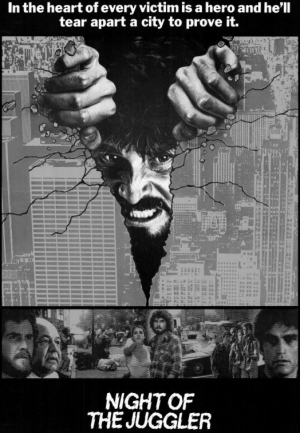 He’s a villain in Night of the Juggler, which is one of the better and most-unsung Dirty Old New York movies, and is sadly one of those not on DVD. So it just becomes more and more hard to see. Night of the Juggler stars James Brolin as an ex-cop truck driver, whose daughter is kidnapped by a psychotic Cliff Gorman. In the movie, Cliff Gorman’s building where he lives is in one of those demolished South Bronx war zones. That movie has a lot of great stuff. I just didn’t put it in, because my copy is crap. It’s from an old VHS. It opens with that great chase, and it also shows you the non-helpful New Yorker. Because it seems really obvious Cliff Gorman is kidnapping this girl, and they’re just walking through subways, and no one is stopping them. There’s a guy chasing them, trying to get his daughter, and no one is stopping Cliff Gorman as he’s just dragging this little girl.
He’s a villain in Night of the Juggler, which is one of the better and most-unsung Dirty Old New York movies, and is sadly one of those not on DVD. So it just becomes more and more hard to see. Night of the Juggler stars James Brolin as an ex-cop truck driver, whose daughter is kidnapped by a psychotic Cliff Gorman. In the movie, Cliff Gorman’s building where he lives is in one of those demolished South Bronx war zones. That movie has a lot of great stuff. I just didn’t put it in, because my copy is crap. It’s from an old VHS. It opens with that great chase, and it also shows you the non-helpful New Yorker. Because it seems really obvious Cliff Gorman is kidnapping this girl, and they’re just walking through subways, and no one is stopping them. There’s a guy chasing them, trying to get his daughter, and no one is stopping Cliff Gorman as he’s just dragging this little girl.
Randy Jurgensen is a friend of mine. I approached him about a year ago, because I wanted to interview him. He’s a perfect example of one of those New York guys that I saw all the time in these movies. You see his name in the production credits, and he’s got a face and a voice that you don’t forget when he’s in front of the camera.
"Who is that Guy?!": Fun City Edition from Jonathan Hertzberg on Vimeo.
Al Pacino’s character in Cruising is largely based on Randy’s undercover experiences in the ’60s, where he was posing as a gay guy in the Village, just like Pacino. If you remember, the Spinell 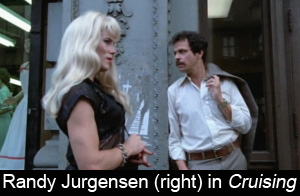 character and the other guy are shaking down the transvestites. The first scene in the movie, we see them forcing the guy to give them a blowjob. Then later on, Paul Sorvino is intimating that these guys might not be real cops. There’s people imitating cops. That was a real case where Randy went undercover to find these guys. They called them “Salt and Pepper,” because one was White and one was Black. They were shaking guys down, but they weren’t real cops. You know, they had uniforms and drove in squad cars. Randy’s career arc was particularly fascinating to me — being a cop, who then segued into being a consultant on films, and then a producer. He was one of those guys that, if you’ve only seen a couple of these movies, you’ve almost certainly seen something that Randy was involved in. Because from The French Connection onward, he’s like one of the go-to guys that all the film production companies would use. He worked with Lustig and Abel Ferrara and Friedkin.
character and the other guy are shaking down the transvestites. The first scene in the movie, we see them forcing the guy to give them a blowjob. Then later on, Paul Sorvino is intimating that these guys might not be real cops. There’s people imitating cops. That was a real case where Randy went undercover to find these guys. They called them “Salt and Pepper,” because one was White and one was Black. They were shaking guys down, but they weren’t real cops. You know, they had uniforms and drove in squad cars. Randy’s career arc was particularly fascinating to me — being a cop, who then segued into being a consultant on films, and then a producer. He was one of those guys that, if you’ve only seen a couple of these movies, you’ve almost certainly seen something that Randy was involved in. Because from The French Connection onward, he’s like one of the go-to guys that all the film production companies would use. He worked with Lustig and Abel Ferrara and Friedkin.
As a police officer, he was involved in so many different milestone cases in one way or another. For instance, the “Career Girls Murders“, he wasn’t a lead investigator on that. But because it was such a  widespread case, he explains that everyone was in on it. There were lead guys on it, but he was doing a lot of the background work as well, like a lot of other homicide detectives. But he’s one of the “French Connection” cops. He’s one of “The Seven-Ups”. If you’ve seen the movie, The Seven-Ups, it’s sort of like a follow-up to The French Connection — an unofficial sequel, of sorts. So French Connection 2, he had nothing to do with. None of the guys, except for Gene Hackman, really are back on that one. But Seven-Ups is like all French Connection personnel. And it’s based on the idea that it’s an elite group of cops that were called “The Seven-Ups”, because they only went after big fish. So Seven-Ups refers to sentences of seven years or more, for whatever they were getting these guys for. So Randy’s one of those guys. We actually did a screening at Anthology Film Archives last year of The Seven-Ups, and Randy came and did a Q&A after. Because I told Randy, “The movies that you’re in, a lot of people don’t know your name. But they know your face, and they definitely know stuff that you worked on. Movies like Maniac, like Vigilante, and the Friedkin movies like Sorcerer, Cruising and The French Connection. Randy, these movies are getting shown at places like Anthology, and it would be cool to do a screening and have you come down. Because it would connect you with a younger audience.”
widespread case, he explains that everyone was in on it. There were lead guys on it, but he was doing a lot of the background work as well, like a lot of other homicide detectives. But he’s one of the “French Connection” cops. He’s one of “The Seven-Ups”. If you’ve seen the movie, The Seven-Ups, it’s sort of like a follow-up to The French Connection — an unofficial sequel, of sorts. So French Connection 2, he had nothing to do with. None of the guys, except for Gene Hackman, really are back on that one. But Seven-Ups is like all French Connection personnel. And it’s based on the idea that it’s an elite group of cops that were called “The Seven-Ups”, because they only went after big fish. So Seven-Ups refers to sentences of seven years or more, for whatever they were getting these guys for. So Randy’s one of those guys. We actually did a screening at Anthology Film Archives last year of The Seven-Ups, and Randy came and did a Q&A after. Because I told Randy, “The movies that you’re in, a lot of people don’t know your name. But they know your face, and they definitely know stuff that you worked on. Movies like Maniac, like Vigilante, and the Friedkin movies like Sorcerer, Cruising and The French Connection. Randy, these movies are getting shown at places like Anthology, and it would be cool to do a screening and have you come down. Because it would connect you with a younger audience.”
On his opinion of Cruising
It’s a movie I first saw some time in the late-’90s at Film Forum. I had known about it. I mean, I had grown up seeing that big box VHS of it with Pacino wearing the leather cap, and I had heard that it’s a terrible movie. It had that reputation as being a train wreck of a film. Then I saw it at Film Forum,  and it was a fairly new print at that time. It had been revived recently in San Francisco, and then it kind of took off from there, and Film Forum showed it. It was really cool, because Film Forum is a couple blocks away from where so much of that movie is shot. I’ve always gotten a kick out of that, when I’ve been in a theater in New York, where you’re watching the film that’s basically taking place right around the corner from where you’re watching it. Anyway, it was interesting, because I knew that Cruising had a bad reputation critically and with the gay community. So I’m waiting in line, and I’m probably the only single straight male in the theater. Since then, there’s been much more of a Cruising revival, and that was sort of like the beginning of it. The first time I watched it, I was totally just blown away. There were certain scenes that, right from the start, I just thought were brilliant. The overall narrative? Like most people, I was asking questions. There’s a lot of ambiguity. It was one of those movies that, as I watched it more times — and I got a VHS copy after seeing it at Film Forum — it just kind of got better and better to me. Now it’s just one of my favorite films in that Dirty Old New York canon, and also as a Hollywood film. Because 33 years later, it’s one of those movies that you still can’t believe a Hollywood studio produced, and that played in Middle America in multiplexes. It’s so envelope-pushing, dirty, nasty, rub-your-nose-in-it. Whether you feel it’s homophobic or not (I don’t feel that it is), I just like it, even if it doesn’t totally make sense on a narrative level. There’s just a lot of rich material there, and it’s a really great snapshot of a very particular time and place.
and it was a fairly new print at that time. It had been revived recently in San Francisco, and then it kind of took off from there, and Film Forum showed it. It was really cool, because Film Forum is a couple blocks away from where so much of that movie is shot. I’ve always gotten a kick out of that, when I’ve been in a theater in New York, where you’re watching the film that’s basically taking place right around the corner from where you’re watching it. Anyway, it was interesting, because I knew that Cruising had a bad reputation critically and with the gay community. So I’m waiting in line, and I’m probably the only single straight male in the theater. Since then, there’s been much more of a Cruising revival, and that was sort of like the beginning of it. The first time I watched it, I was totally just blown away. There were certain scenes that, right from the start, I just thought were brilliant. The overall narrative? Like most people, I was asking questions. There’s a lot of ambiguity. It was one of those movies that, as I watched it more times — and I got a VHS copy after seeing it at Film Forum — it just kind of got better and better to me. Now it’s just one of my favorite films in that Dirty Old New York canon, and also as a Hollywood film. Because 33 years later, it’s one of those movies that you still can’t believe a Hollywood studio produced, and that played in Middle America in multiplexes. It’s so envelope-pushing, dirty, nasty, rub-your-nose-in-it. Whether you feel it’s homophobic or not (I don’t feel that it is), I just like it, even if it doesn’t totally make sense on a narrative level. There’s just a lot of rich material there, and it’s a really great snapshot of a very particular time and place.
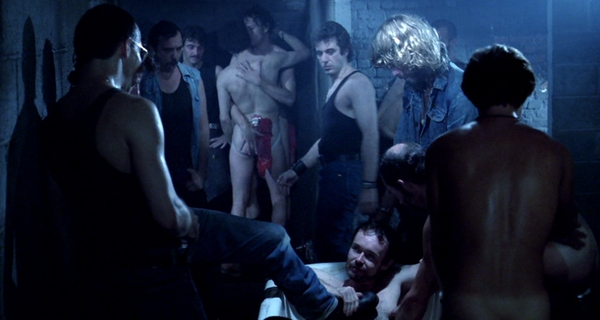
I’ve never really considered myself a major Al Pacino fan per se. And If I had to choose between the two of them, I’m maybe more partial to Dustin Hoffman. It’s really hard to say. But as I’ve been doing this thing, I’ve found that Pacino just has quite a roster of iconic parts from that period. One of the things that I’ve tried to do is find the humor in a lot of these films. Cruising is a good example of that. It’s a very dark film. But there’s just a lot of stuff which, especially when you see it with an audience, it’s just laugh-out-loud. I mean, I’m not laughing at the movie. There’s just stuff in there, it’s funny, and you’re laughing with it. So you’ve probably noticed in these videos that I’m having fun with these things. But not at the movie’s expense, I don’t think.
On actresses who stand out in the Fun City series
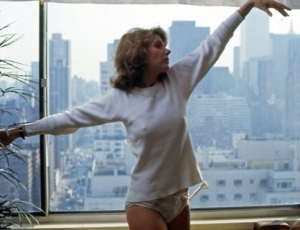 I have some clips of An Unmarried Woman, and I have a brief clip of Melanie Mayron in Girlfriends. I should have more of her. Also, Up the Down Staircase. I don’t have enough of it, to be honest. As great as the ’70s era was for film overall, and as much as I’m obviously a huge proponent and lover of that era on film, in a lot of ways it was a very male-centric male-dominated period. There’s a few women filmmakers, but a lot of it is coming from a male point of view. It’s reflective in general of the evolution of women’s rights at the time. It’s not really until the late-’70s and early-’80s, and the beginnings of the independent film movement, that you have more women filmmakers getting a chance to have a voice. So I had some stuff from something like Smithereens in there — the Susan Seidelman film. But there are films like An Unmarried Woman, for instance, with Jill Clayburgh. It’s a Paul Mazursky film, and I think Mazursky is still one of the more underrated New York auteurs. You know, he had some hits in his day. I’ve used An
I have some clips of An Unmarried Woman, and I have a brief clip of Melanie Mayron in Girlfriends. I should have more of her. Also, Up the Down Staircase. I don’t have enough of it, to be honest. As great as the ’70s era was for film overall, and as much as I’m obviously a huge proponent and lover of that era on film, in a lot of ways it was a very male-centric male-dominated period. There’s a few women filmmakers, but a lot of it is coming from a male point of view. It’s reflective in general of the evolution of women’s rights at the time. It’s not really until the late-’70s and early-’80s, and the beginnings of the independent film movement, that you have more women filmmakers getting a chance to have a voice. So I had some stuff from something like Smithereens in there — the Susan Seidelman film. But there are films like An Unmarried Woman, for instance, with Jill Clayburgh. It’s a Paul Mazursky film, and I think Mazursky is still one of the more underrated New York auteurs. You know, he had some hits in his day. I’ve used An 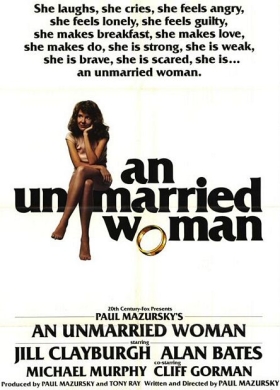 Unmarried Woman a few times so far in the videos. But I actually didn’t see it, until much more recently than I should have. It was a big hit in its day, and Jill Clayburgh is amazing in the film. Its basically her movie, and about what happens to her after her husband reveals that he’s been having an affair with a younger woman, and they break up. Then its just her navigating these waters as a single woman in her 30s with a teenage daughter in late-’70s New York. I think it holds up pretty well. That’s the kind of story that can become very outdated, and it is coming from a male director. But I thought it was a really strong pro-woman’s film. Even though it’s not directed by a woman, I think it comes off still as a pretty brave and very progressive film. Even now, I don’t think it looks terribly behind the times, in a lot of ways. I’m obviously biased, but I don’t see Hollywood producing as mature of films as that in this day and age. So that’s one of the ones I really wanted to try to get a showcase for in these videos.
Unmarried Woman a few times so far in the videos. But I actually didn’t see it, until much more recently than I should have. It was a big hit in its day, and Jill Clayburgh is amazing in the film. Its basically her movie, and about what happens to her after her husband reveals that he’s been having an affair with a younger woman, and they break up. Then its just her navigating these waters as a single woman in her 30s with a teenage daughter in late-’70s New York. I think it holds up pretty well. That’s the kind of story that can become very outdated, and it is coming from a male director. But I thought it was a really strong pro-woman’s film. Even though it’s not directed by a woman, I think it comes off still as a pretty brave and very progressive film. Even now, I don’t think it looks terribly behind the times, in a lot of ways. I’m obviously biased, but I don’t see Hollywood producing as mature of films as that in this day and age. So that’s one of the ones I really wanted to try to get a showcase for in these videos.
On intercutting different films to produce an interaction between them
The first time I did that in the subway video was with Saturday Night Fever and The Warriors. I remember when I was a high school kid, and discovering a lot of these movies, I would go to the library and read the books that collected reviews of different critics. I remember that Pauline Kael’s 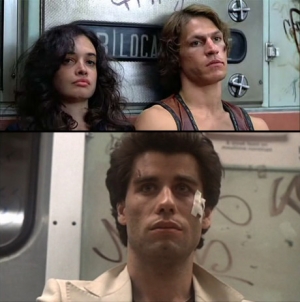 take on The Warriors was very complimentary. She specifically talked about how, in 1977, we thought Saturday Night Fever was showing us teenagers that had it rough in the city — showing us the bottom of the barrel. Then The Warriors, even though it’s very comic book-like and far-from-reality, it made Tony Manero and his little milieu seem like a step up. And so visually, I had made some connections before between Saturday Night Fever, and The Warriors riding on the train at night towards the end of their journey. The subway was always kind of the reprieve for them, and a place where they could get a breather. In that last part, where they’re all falling asleep, they sort of take on a childlike image as they’re coming home. And in Saturday Night Fever, the subway is this place where Tony Manero rides by himself at night. It’s very cathartic, and he’s trying to come to terms with things. It’s on the subway where a lot of that happens. Anyway, that’s part of the reason why I threw those guys together like that. Plus, the lighting just kind of matched up well, and the train car models that they were riding were both similar. Because you notice in the subway video, there’s all kinds of trains — whether it’s IRT versus BMT, or just different eras of trains. There’s people on these subway message boards online that are real train enthusiasts. They were commenting
take on The Warriors was very complimentary. She specifically talked about how, in 1977, we thought Saturday Night Fever was showing us teenagers that had it rough in the city — showing us the bottom of the barrel. Then The Warriors, even though it’s very comic book-like and far-from-reality, it made Tony Manero and his little milieu seem like a step up. And so visually, I had made some connections before between Saturday Night Fever, and The Warriors riding on the train at night towards the end of their journey. The subway was always kind of the reprieve for them, and a place where they could get a breather. In that last part, where they’re all falling asleep, they sort of take on a childlike image as they’re coming home. And in Saturday Night Fever, the subway is this place where Tony Manero rides by himself at night. It’s very cathartic, and he’s trying to come to terms with things. It’s on the subway where a lot of that happens. Anyway, that’s part of the reason why I threw those guys together like that. Plus, the lighting just kind of matched up well, and the train car models that they were riding were both similar. Because you notice in the subway video, there’s all kinds of trains — whether it’s IRT versus BMT, or just different eras of trains. There’s people on these subway message boards online that are real train enthusiasts. They were commenting 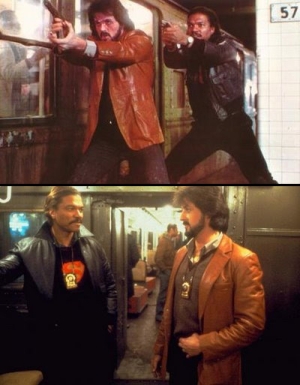 on that video, like, “In the video, there’s a sound, but it’s from this train. And it doesn’t match up with the train that you’re actually seeing.” I mean, they know how the trains sound. Not just how they look. Those people are obsessive, and they know all the model numbers and everything. They’re talking about how in Nighthawks — and even I could spot this — the train that you see is like a way, way out-of-date train for when that movie was shot. The scene with Stallone and Billy Dee Williams, that train is like the kind of train you see when the Transit Museum is wheeling out one of the antique trains. It was definitely not in service in 1980 when they were shooting that movie. It’s got the wicker seats, which had gone out in the ’60s.
on that video, like, “In the video, there’s a sound, but it’s from this train. And it doesn’t match up with the train that you’re actually seeing.” I mean, they know how the trains sound. Not just how they look. Those people are obsessive, and they know all the model numbers and everything. They’re talking about how in Nighthawks — and even I could spot this — the train that you see is like a way, way out-of-date train for when that movie was shot. The scene with Stallone and Billy Dee Williams, that train is like the kind of train you see when the Transit Museum is wheeling out one of the antique trains. It was definitely not in service in 1980 when they were shooting that movie. It’s got the wicker seats, which had gone out in the ’60s.
The Woody Allen scene from Bananas was another one pretty early on, where it really reminded me of the scene from Death Wish on the train — and that it would work well to have Bronson reacting against the young Sylvester Stallone. And it’s obviously funny to see Woody Allen taking care of these two thugs. Although, there’s more in the scene which I didn’t include in the subway scene, because it didn’t go with it. But if you’ve seen the movie, they get back in the train. The doors close, and then in my video I just made it so the doors stay closed. But in the actual movie, the doors open back up. Woody looks pretty good in the way I cut it.
On Fun City films that comment on the city’s high crime rate
 The Incident is not on DVD, but I actually saw a print of it a couple of years ago at one the screenings at Anthology Film Archives for the “Lustig Presents” series. I don’t really think it’s particularly overall a very good film. But it has some real impactful stuff. Especially when you figure that the film is from 1967, so it’s really pre-ratings code. It’s got some pretty intense stuff. It’s one of those movies that’s responding to something like the Kitty Genovese murder. The idea being that this woman was screaming for her life, and no one came to help her, until it was too late. That was one of those watershed moments in the city’s history, and that’s kind of what that movie’s responding to and criticizing. People just sort of sitting there, and saying, “I’m gonna mind my own business. It’s not bothering me.” That kind of thing.
The Incident is not on DVD, but I actually saw a print of it a couple of years ago at one the screenings at Anthology Film Archives for the “Lustig Presents” series. I don’t really think it’s particularly overall a very good film. But it has some real impactful stuff. Especially when you figure that the film is from 1967, so it’s really pre-ratings code. It’s got some pretty intense stuff. It’s one of those movies that’s responding to something like the Kitty Genovese murder. The idea being that this woman was screaming for her life, and no one came to help her, until it was too late. That was one of those watershed moments in the city’s history, and that’s kind of what that movie’s responding to and criticizing. People just sort of sitting there, and saying, “I’m gonna mind my own business. It’s not bothering me.” That kind of thing.
I enjoy Death Wish quite a bit. I consider it a piece of pulp. Like a lot of films from that era, it has a documentary-like feel. It’s shot in a realistic way. And then you have characters that are spouting statistics about how unsafe New York is, versus other parts of the country — like the Sun Belt in 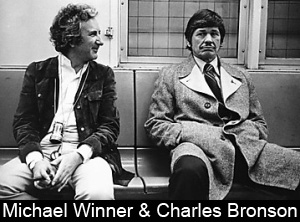 Arizona, where the character has a little vacation before he comes back to the city. So I enjoy it, but I don’t take it seriously. Especially after reading up on it more. There’s a couple of good monographs that have been put out on Death Wish, talking about how it’s like a lot of films from that time period that were made to play on people’s fear of New York, fear of the city. So I think a lot of that is a little over-the-top, or at the time it probably was. But now, so much time has passed that it’s easy to step away from the political ramifications that were going on around a film like that at the time. Now I can enjoy it as a well-made film. I don’t think Michael Winner is a great filmmaker by any means. But it’s fun if you don’t take it very seriously. And I think that’s true of a lot of these films.
Arizona, where the character has a little vacation before he comes back to the city. So I enjoy it, but I don’t take it seriously. Especially after reading up on it more. There’s a couple of good monographs that have been put out on Death Wish, talking about how it’s like a lot of films from that time period that were made to play on people’s fear of New York, fear of the city. So I think a lot of that is a little over-the-top, or at the time it probably was. But now, so much time has passed that it’s easy to step away from the political ramifications that were going on around a film like that at the time. Now I can enjoy it as a well-made film. I don’t think Michael Winner is a great filmmaker by any means. But it’s fun if you don’t take it very seriously. And I think that’s true of a lot of these films.
In a similar way to something like Death Wish, I feel like there are movies (Vigilante, in particular) that really play on those fears of New York. I mean, the stereotypical view of the city from everywhere  else in the country or the world. Vigilante is a good example, in that it’s very much a Death Wish-inspired piece. It goes in a similar direction, where it just gets about as far away from reality as you can get. Yet the way it’s told, and the way it’s done, is sort of a pseudo-documentary way. So again, I don’t necessarily agree with all the politics of it. I go along with it. I just don’t take it very seriously. It plays better now as many years have gone on, because of the fact it takes on this actual documentary quality, which it didn’t necessarily take on when it was trying to. It’s because of the way Lustig made his films. Maybe not Maniac as much, but Vigilante I keep coming back to. I think he was going for something hard-hitting, and maybe exaggerated, but coming from real problems. For me, it actually does have a documentary kind of function. But not on a social or a political level. It’s purely on a level where it’s showing us New York (and in the case of Vigilante, Greenpoint and Williamsburg in particular) 30 years on, and how different it is now. I mean, Vigilante is amazing to watch, just because of the fact that this whole chase is happening on McGuinness Boulevard. It’s supposed to be a really seedy area where he’s chasing the gang member who killed his kid. And now, it’s the middle of Greenpoint and Williamsburg. It’s about as far away from that as you can get.
else in the country or the world. Vigilante is a good example, in that it’s very much a Death Wish-inspired piece. It goes in a similar direction, where it just gets about as far away from reality as you can get. Yet the way it’s told, and the way it’s done, is sort of a pseudo-documentary way. So again, I don’t necessarily agree with all the politics of it. I go along with it. I just don’t take it very seriously. It plays better now as many years have gone on, because of the fact it takes on this actual documentary quality, which it didn’t necessarily take on when it was trying to. It’s because of the way Lustig made his films. Maybe not Maniac as much, but Vigilante I keep coming back to. I think he was going for something hard-hitting, and maybe exaggerated, but coming from real problems. For me, it actually does have a documentary kind of function. But not on a social or a political level. It’s purely on a level where it’s showing us New York (and in the case of Vigilante, Greenpoint and Williamsburg in particular) 30 years on, and how different it is now. I mean, Vigilante is amazing to watch, just because of the fact that this whole chase is happening on McGuinness Boulevard. It’s supposed to be a really seedy area where he’s chasing the gang member who killed his kid. And now, it’s the middle of Greenpoint and Williamsburg. It’s about as far away from that as you can get.
In some of those movies (Vigilante being one, and The Warriors being another) there are these really improbably Hollywood-like mixed-race, mixed-gender gangs. I give The Warriors more of a pass, because The Warriors to me is never pretending to be anything but a comic book movie.

It’s not supposed to be real. Although, Walter Hill originally wanted the gang to be all-Black, and the studio said, “No.” But in Vigilante, I feel like Lustig’s going for something a little more sensational. There’s more of a political commentary being made. It’s supposed to be more realistic. So I have more of a problem with the gang in that one, personally. And some of the stuff (like the way the court case is handled) I felt like the cards are a little too stacked in favor of the point of view of the corrupt pro-criminal justice system. To put Vigilante anywhere in the same discussion as something like Prince of the City, there’s no comparison in terms of being anything you can really take seriously. I can take Vigilante seriously as a good piece of exploitation filmmaking. I mean, it’s great on that level.
On whether NYC’s portrayal on film made tourists not want to visit
I really think it depends on the person watching the movie, to be honest. If you already had an opinion that New York was the armpit of America, obviously the movie’s not gonna change your mind. If you love New York, and when you actually went there you had a good experience, and didn’t come into contact with thugs — like Bronson seems to every time he goes out — then you’re gonna look 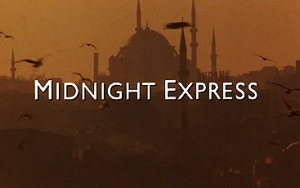 at the movie and probably say, “It’s entertaining, but it’s a little bit of an exaggeration.” It’s interesting. To this point (and this has to do with a totally different place), I do know that something like Midnight Express had a very, very palpable impact on tourism, and just overall perceptions in the West of Turkey. I have Turkish friends that won’t watch that movie, and other ones that don’t take it that seriously. But at the time, that movie had a pretty huge negative impact for a long time. For a lot of people, that’s all they knew of Turkey. And that film’s not a very fair portrayal.
at the movie and probably say, “It’s entertaining, but it’s a little bit of an exaggeration.” It’s interesting. To this point (and this has to do with a totally different place), I do know that something like Midnight Express had a very, very palpable impact on tourism, and just overall perceptions in the West of Turkey. I have Turkish friends that won’t watch that movie, and other ones that don’t take it that seriously. But at the time, that movie had a pretty huge negative impact for a long time. For a lot of people, that’s all they knew of Turkey. And that film’s not a very fair portrayal.
People are watching these [Fun City-era] movies now, and then looking at this very colorless, Disney-fied city. Nowhere better embodied than by Times Square, and what’s happened to that area. So you get these comment strands on some of my videos where people are either pining for those bad old days, or other people saying, “Yeah, if you were actually there when it was happening, you would not be wishing for that to come back.” It’s interesting that when those films 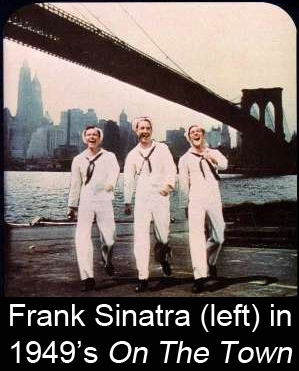 were really made, you had people like Ernest Borgnine and Frank Sinatra who were still active. And we had seen those guys in movies from earlier, when they were younger. They had definitely been in movies shot in New York, or taken place in New York, at a totally different time. You know, something that could be interesting would be to show some clips of Sinatra as a young man in one of the musicals, and Borgnine in Marty or something. But it is interesting to see the older guys commenting on the shithole that New York’s become. And in the same part of that video, you have the scene from Cruising with Spinnel, which I think is just so brilliant. I love that scene in the squad car. Because that’s early in the movie, before you even see Pacino. I mean, that was when I was like, “I don’t know what the fuck is going on here, but this is special.” And I still think that. It’s a scene with Spinell in the squad car, and there’s no sound, except the audio of the guys talking. And the people out on the street, it’s all quiet. I mean, it’s just very haunting. The sound design in that movie is really amazing. So I put stuff in where people are saying, “This city is going to shit.”
were really made, you had people like Ernest Borgnine and Frank Sinatra who were still active. And we had seen those guys in movies from earlier, when they were younger. They had definitely been in movies shot in New York, or taken place in New York, at a totally different time. You know, something that could be interesting would be to show some clips of Sinatra as a young man in one of the musicals, and Borgnine in Marty or something. But it is interesting to see the older guys commenting on the shithole that New York’s become. And in the same part of that video, you have the scene from Cruising with Spinnel, which I think is just so brilliant. I love that scene in the squad car. Because that’s early in the movie, before you even see Pacino. I mean, that was when I was like, “I don’t know what the fuck is going on here, but this is special.” And I still think that. It’s a scene with Spinell in the squad car, and there’s no sound, except the audio of the guys talking. And the people out on the street, it’s all quiet. I mean, it’s just very haunting. The sound design in that movie is really amazing. So I put stuff in where people are saying, “This city is going to shit.”
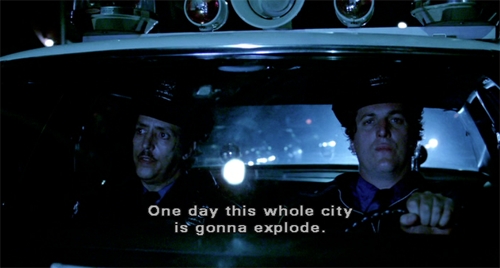
The Sinatra scene is from a movie I only just saw fairly recently, called The First Deadly Sin, which is Sinatra’s last starring role in a movie. It’s not a critically well-regarded film, so I didn’t have too many high expectations for it. But I thought it was actually really well done. More people should definitely see it. It’s directed by Brian G. Hutton, who had earlier on done some pretty big all-star cast action films in the ’60s, like Where Eagles Dare and Kelly’s Heroes. It was one of the last things 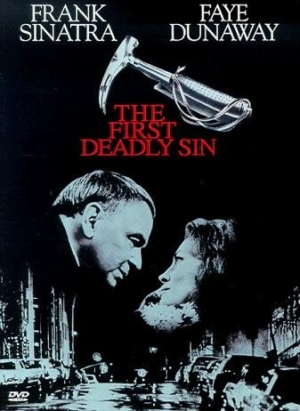 that he did, I believe, before he left the industry. But The First Deadly Sin is like a serial killer, American Giallo-type of movie. Sinatra’s a cop who’s about to retire. He’s sort of the only guy who’s on this case, and figuring stuff out — even though he’s the old guy who is supposed to be past his expiration date. But there is a lot of really good New York footage in there, and that line where he says, “Nowhere’s safe anymore,” after the guy before refers to West 81st Street. He says, “I thought that was a safe area”. That’s actually very interesting, because that’s connected to something I heard Randy talking about.
that he did, I believe, before he left the industry. But The First Deadly Sin is like a serial killer, American Giallo-type of movie. Sinatra’s a cop who’s about to retire. He’s sort of the only guy who’s on this case, and figuring stuff out — even though he’s the old guy who is supposed to be past his expiration date. But there is a lot of really good New York footage in there, and that line where he says, “Nowhere’s safe anymore,” after the guy before refers to West 81st Street. He says, “I thought that was a safe area”. That’s actually very interesting, because that’s connected to something I heard Randy talking about.
I sat in on an interview where Randy was talking about the “Career Girls Murders” for a TV program. He specifically talked about that murder taking place in a supposedly-safe area. I think it was like 86th or 96th Street. That was supposed to be the cut-off. The bad shit happened above, and below that was supposed to be a safer area. Of course, this murder happened in the area that was supposed to be safe, so I thought it was interesting when I saw The First Deadly Sin. It struck me that the Sinatra line, that exchange, is definitely coming from some real life cop experiences, or the way those guys would have looked at different places and different street numbers.
On Fun City films that highlight police corruption
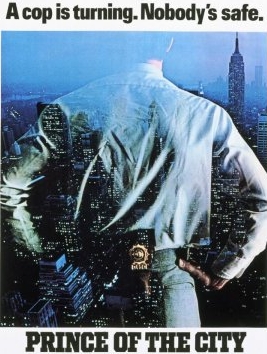 I remember I said to Randy, “After French Connection, you were really in demand.” Because there were all these movie productions happening in New York that were cop-specific. And he said the one thing he turned down was Serpico. It was the only one he didn’t wanna do. But he also told me at another point that Treat Williams’ performance in Prince of the City is like his favorite cop performance. Serpico is a pretty black-and-white film. It’s pretty much like Serpico is a saint, and everyone else is a real bad apple. Prince of the City is a little more nuanced, and it definitely is more ambiguous. It’s a more challenging film, because there’s more of a question when the movie’s over, “Do you like this guy? Do you think he’s heroic, or do you think he’s a scumbag? Do you think he’s a rat, and that he should have got it as much as the other guys got it?” I think Sidney Lumet talked about how he wasn’t totally sure if he liked this guy or not. I’ve seen that movie several times, and it’s definitely one of those things where you could feel differently about him under different viewings.
I remember I said to Randy, “After French Connection, you were really in demand.” Because there were all these movie productions happening in New York that were cop-specific. And he said the one thing he turned down was Serpico. It was the only one he didn’t wanna do. But he also told me at another point that Treat Williams’ performance in Prince of the City is like his favorite cop performance. Serpico is a pretty black-and-white film. It’s pretty much like Serpico is a saint, and everyone else is a real bad apple. Prince of the City is a little more nuanced, and it definitely is more ambiguous. It’s a more challenging film, because there’s more of a question when the movie’s over, “Do you like this guy? Do you think he’s heroic, or do you think he’s a scumbag? Do you think he’s a rat, and that he should have got it as much as the other guys got it?” I think Sidney Lumet talked about how he wasn’t totally sure if he liked this guy or not. I’ve seen that movie several times, and it’s definitely one of those things where you could feel differently about him under different viewings.
My reasoning for putting in different portrayals of cops probably has to do with my own, and a lot of people’s, different or ambiguous feelings about the police. I think I’ve had feelings of skepticism or 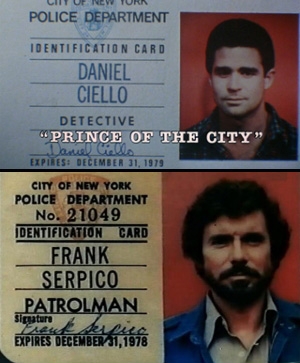 disagreements, or not being on the side of police. I haven’t been arrested, but I’ve had feelings of disappointment or anger about things that police have been involved in. And then also, I have admiration for them, and what they stand for — at least, in theory — and overall, how they function in what they do for us. So a lot of those movies, whether it’s Serpico or Prince of the City or some of the other films, show cops that are in heroic form, in humorous form, and in despicable form.
disagreements, or not being on the side of police. I haven’t been arrested, but I’ve had feelings of disappointment or anger about things that police have been involved in. And then also, I have admiration for them, and what they stand for — at least, in theory — and overall, how they function in what they do for us. So a lot of those movies, whether it’s Serpico or Prince of the City or some of the other films, show cops that are in heroic form, in humorous form, and in despicable form.
There’s a lot of really upsetting or shocking scenes in Prince of the City. There’s that scene close to the beginning where he’s beating up one junkie to go feed his informant. I was trying to show that the fun stuff can turn into tragedy. There’s some scenes of Roy Scheider in French Connection where he’s kicking the guy when he’s down — even though Roy Scheider is sort of like the good cop in the “good cop/bad cop” thing with him and Gene Hackman. But it makes it look like Scheider’s the bad guy, because he’s kicking the guy. And then I have him in The Seven-Ups at the end there, shooting the bad guy. It’s pretty violent. Maybe it’s a little overdone. But the shot of his face — he could be thinking a million things, but he definitely looks pretty shook up. So it worked for the transition I was going for, showing how there’s a recognition that it’s pretty heavy. It’s not a comic book. The way the guy dies is pretty realistic. That actor was Richard Lynch, and I’m sure you’ve seen him in other movies.

He was a pretty weird-looking guy. Part of the reason he looks that way, and Randy Jurgensen told me when we did The Seven-Ups screening, was that he was actually a pacifist. At a protest against the war in Vietnam, before he was an actor I guess, he lit himself on fire. So that’s why when you see him sometimes in close-ups, you can see the scars where he was burnt. So that’s part of how he has that pretty unique look. Apparently he actually really hated guns, but he’s a killer in the movie. He’s one of the bad guys. But he was a pacifist and really didn’t want to handle guns at all.
On the dangers for New Yorkers riding the subway in Fun City films
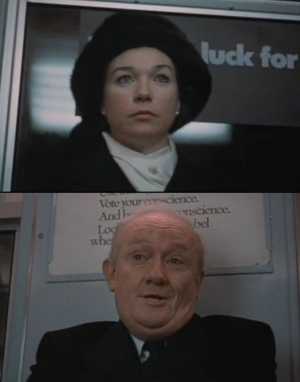 There’s a lot of scenes where it’s just people riding the train. Obviously there is that threat, and I do have quite a bit of menacing stuff that’s going on. But then you also have stuff like Desperate Characters with Shirley MacLaine, where there’s an old guy who’s talking to himself on the train. It’s a classic New York moment, where there’s a crazy guy having a conversation with himself, and no one’s reacting to it. That to me is a quintessential subway moment, just as much as the muggings. You know, I’ve been mugged, but never actually on the subway. It was on the street in Clinton Hill where I used to live. And I’d lived there ten years before that happened to me. But with the train stuff, for me it was not as much that the subway wasn’t safe back then. It was more about showing these places that are in the city where we live, and how much these locations change over the years. Just how these movies end up having this dual role. Besides telling their own story, as the years go on, they are documenting these places. Because things continually change and get torn down, and new things are built over them. My thinking with the subway was, we ride it every day. But over the years, a lot changes. Whether it’s to the types of cars that you’re riding, or new subway stations being built, or old ones that are being torn down or totally remodeled. So within these films, obviously there’s stuff where people are being menaced or killed. Then there’s also lots of scenes of people just going about
There’s a lot of scenes where it’s just people riding the train. Obviously there is that threat, and I do have quite a bit of menacing stuff that’s going on. But then you also have stuff like Desperate Characters with Shirley MacLaine, where there’s an old guy who’s talking to himself on the train. It’s a classic New York moment, where there’s a crazy guy having a conversation with himself, and no one’s reacting to it. That to me is a quintessential subway moment, just as much as the muggings. You know, I’ve been mugged, but never actually on the subway. It was on the street in Clinton Hill where I used to live. And I’d lived there ten years before that happened to me. But with the train stuff, for me it was not as much that the subway wasn’t safe back then. It was more about showing these places that are in the city where we live, and how much these locations change over the years. Just how these movies end up having this dual role. Besides telling their own story, as the years go on, they are documenting these places. Because things continually change and get torn down, and new things are built over them. My thinking with the subway was, we ride it every day. But over the years, a lot changes. Whether it’s to the types of cars that you’re riding, or new subway stations being built, or old ones that are being torn down or totally remodeled. So within these films, obviously there’s stuff where people are being menaced or killed. Then there’s also lots of scenes of people just going about 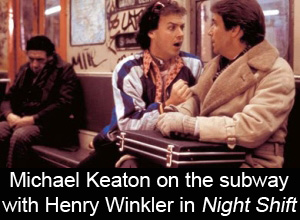 their daily business, and they’re riding the train. A good example is that scene in Night Shift. It’s one of my favorite movies, and has some really good subway scenes in there. I also wanted to make sure I got something in of someone going in the train station where they had to use a token. You know, there was no MetroCard obviously. So I just feel that the overall purpose is not as much to show that the subway is not a safe place, but more that it’s just different now, and all the different ways it functions within these films. I’m still collecting footage, actually. Because people make suggestions about things, or I end up remembering a film I forgot to include. I’m gonna stick a lot of stuff in the next part, which hasn’t appeared anywhere yet.
their daily business, and they’re riding the train. A good example is that scene in Night Shift. It’s one of my favorite movies, and has some really good subway scenes in there. I also wanted to make sure I got something in of someone going in the train station where they had to use a token. You know, there was no MetroCard obviously. So I just feel that the overall purpose is not as much to show that the subway is not a safe place, but more that it’s just different now, and all the different ways it functions within these films. I’m still collecting footage, actually. Because people make suggestions about things, or I end up remembering a film I forgot to include. I’m gonna stick a lot of stuff in the next part, which hasn’t appeared anywhere yet.
There is a Super 8 reel that my late father, Harry shot sometime in ’69 in “Fun City.” I only became acquainted with it in the last year, while I was working on the video project.
Fun City – '69 from Jonathan Hertzberg on Vimeo.
On the graffiti that appears in Fun City films
It definitely comes out the most in the subway video. It was not my overriding goal to have footage of graffiti there. Some of the other things? Yes. I had specific sections, because I was trying to find ways I could put as much of this footage in as I could. I felt like I had to justify it by having some kind of  connection. So there’s shots of people walking in front of walls with graffiti. But the subway video is a good example, because of course you’re going to have graffiti in there. So it’s interesting that some of the sites that have really picked up on it were graffiti enthusiast websites and skateboarding sites. They’re like from Germany and Japan and Russia, France, Italy. Also, hip hop sites. All these little strands of different subcultures, which are related in one way or another. Those people really seem to pick up on the video. It’s interesting, I never really got as much response from cinema websites. It was more from graffiti or skateboard or hip hop or street art sites. Things like that. The stuff that to me is really visually interesting is on the trains. When I see those pictures, like anyone, they’re pretty amazing pieces. You know, a movie like Wild Style is prominently featured in the video. I didn’t put Style Wars in there, but I’m a big fan of that as well. A lot of times it’s really just in the background. There’s a few films, like Wild Style or Beat Street or Style Wars, where the graffiti artist is the protagonist, and it’s the real propelling aspect of the narrative. Then other stuff is just in the background. To me, it’s part of the landscape, part of the fabric. It’s color. I mean, literally and figuratively. There’s some movies
connection. So there’s shots of people walking in front of walls with graffiti. But the subway video is a good example, because of course you’re going to have graffiti in there. So it’s interesting that some of the sites that have really picked up on it were graffiti enthusiast websites and skateboarding sites. They’re like from Germany and Japan and Russia, France, Italy. Also, hip hop sites. All these little strands of different subcultures, which are related in one way or another. Those people really seem to pick up on the video. It’s interesting, I never really got as much response from cinema websites. It was more from graffiti or skateboard or hip hop or street art sites. Things like that. The stuff that to me is really visually interesting is on the trains. When I see those pictures, like anyone, they’re pretty amazing pieces. You know, a movie like Wild Style is prominently featured in the video. I didn’t put Style Wars in there, but I’m a big fan of that as well. A lot of times it’s really just in the background. There’s a few films, like Wild Style or Beat Street or Style Wars, where the graffiti artist is the protagonist, and it’s the real propelling aspect of the narrative. Then other stuff is just in the background. To me, it’s part of the landscape, part of the fabric. It’s color. I mean, literally and figuratively. There’s some movies 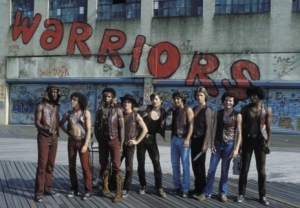 where it actually existed, where it was just there as part of a location. There’s other movies where the art department made the graffiti. A good example is in The Warriors. If you look at the back of the video box, they’ve always used a promotional still of the gang in front of the bathhouse in Coney Island — which has been demolished for like 20 years now. But someone spray painted “Warriors” on a diagonal on the building. And then there’s lots of other graffiti of different names, and things like that. It was all done by the art department of The Warriors, and then it stayed on there. They never cleaned it off. So for years that building was boarded up, but you could still see “Warriors” on there, but faded.
where it actually existed, where it was just there as part of a location. There’s other movies where the art department made the graffiti. A good example is in The Warriors. If you look at the back of the video box, they’ve always used a promotional still of the gang in front of the bathhouse in Coney Island — which has been demolished for like 20 years now. But someone spray painted “Warriors” on a diagonal on the building. And then there’s lots of other graffiti of different names, and things like that. It was all done by the art department of The Warriors, and then it stayed on there. They never cleaned it off. So for years that building was boarded up, but you could still see “Warriors” on there, but faded.
On Ralph Bakshi’s animated versions of Fun City-era New York City
I’ve been watching those Bakshi films since I was probably like 14, when I discovered him in high school. The fact of the matter is there’s really no one else who does anything else like Bakshi. So aside from Heavy Metal, there isn’t really any other North American-produced adult animation. And I did actually put a clip from Heavy Metal in there from the scene with Harry Canyon and his cab. But with Bakshi, besides being the only game in town for that, he’s also a New York guy. He may be the least-appreciated of the “dirty old New York” auteurs — a guy who reveled in the stink of those streets, and made it an intrinsic part of his autobiographical New York-set films.

Those movies, particularly Heavy Traffic and Coonskin and Fritz the Cat and American Pop — a friend of mine who just watched these recently, he told me, “You really should send these to Bakshi. Because he’s on Twitter, and he would really get a kick out of it if he hasn’t seen them.” Bakshi just seems like a guy who really got it. He’s a product of it, and he really gets it. Those films really kind of revel in all these different things that we think of and associate with “Fun City”, or the old New York. So it just seemed like a natural fit. Also, it just visually changes things up a little. It’s a little more interesting to be able to put some animated versions of these things in there.
On the architecturally-focused film, Los Angeles Plays Itself
I saw Los Angeles Plays Itself at Cinema Village when it came out in 2003. I walked out of there, and I remember thinking, “I’m not an L.A. guy. I’m from here. But I still enjoyed that whole film immensely, and was totally enthralled the whole way through.” Then I thought that doing  something similar with New York clips would be fun to do. But then I didn’t really do anything with it, obviously, for many years. Then I kind of just got more back into this whole video editing thing. I had a roommate who showed me a few things on Final Cut. My knowledge of it is quite rudimentary, actually. But he showed me an easy way to rip footage, and then I kind of just liked the idea. I mean, I did some other things that were not New York ones. The first one I did was a short piece on what I call “Sunshine Noir,” which is also very location-based. There was a group of films from the early-80s that are neo-noirs that I felt had a lot of similarities, in terms of the milieu, in terms of some of the repeating motifs — like people driving flashy sports cars, and lots of palm trees, and things like that. But the New York thing was definitely always in the back of my mind.
something similar with New York clips would be fun to do. But then I didn’t really do anything with it, obviously, for many years. Then I kind of just got more back into this whole video editing thing. I had a roommate who showed me a few things on Final Cut. My knowledge of it is quite rudimentary, actually. But he showed me an easy way to rip footage, and then I kind of just liked the idea. I mean, I did some other things that were not New York ones. The first one I did was a short piece on what I call “Sunshine Noir,” which is also very location-based. There was a group of films from the early-80s that are neo-noirs that I felt had a lot of similarities, in terms of the milieu, in terms of some of the repeating motifs — like people driving flashy sports cars, and lots of palm trees, and things like that. But the New York thing was definitely always in the back of my mind.
Sunshine NOIR from Jonathan Hertzberg on Vimeo.
On his approach to inserting occasional subtitles in his videos
 I don’t particularly like hearing my voice on recording — whether I’m hearing it on my voice mail or whatever. And I don’t have that voiceover guy that Thom Andersen has. But I wanted to more or less have the points that are being made. I just like the idea of having it done visually. Sometimes people aren’t gonna get the connection that I’m trying to make, so I add in a little bit of text. I added it in a scene of Pacino in Serpico in front of piled meat, because it’s the meatpacking district. Then I had a scene of Cruising with the meat hooks. Then there’s a scene from Author! Author!, also with Pacino, where he’s in Chinatown and the Chinese restaurant has the chickens hanging from the meat hooks. I just felt like in that case, the text was a good idea. I showed it to someone without it, and tried to see if they saw any correlation. They didn’t seem to, so I decided to add the text there.
I don’t particularly like hearing my voice on recording — whether I’m hearing it on my voice mail or whatever. And I don’t have that voiceover guy that Thom Andersen has. But I wanted to more or less have the points that are being made. I just like the idea of having it done visually. Sometimes people aren’t gonna get the connection that I’m trying to make, so I add in a little bit of text. I added it in a scene of Pacino in Serpico in front of piled meat, because it’s the meatpacking district. Then I had a scene of Cruising with the meat hooks. Then there’s a scene from Author! Author!, also with Pacino, where he’s in Chinatown and the Chinese restaurant has the chickens hanging from the meat hooks. I just felt like in that case, the text was a good idea. I showed it to someone without it, and tried to see if they saw any correlation. They didn’t seem to, so I decided to add the text there.
On keeping up his blog, and continue the Fun City video series
I’m writing this stuff, or making these videos, primarily because I have such a strong response or personal connection to these films. I think it’s common for cinephiles. Whether it’s people keeping a journal, or keeping a blog, having some kind of commentary means the movie has some kind of life 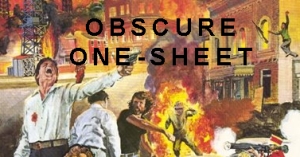 with you after you’ve already watched it. That being said, it’s nice to know that some people actually read it and comment on it. I do like getting comments, and I do like getting views for sure. I had done a lot of videos before that struggled to get any views. I also didn’t do much to promote them, besides putting them on my blog, and maybe sometimes on my Facebook page or Twitter. But then the subway video was the first thing that ever went way beyond anything I had ever experienced before. Still relatively small, but it was very cool to get the kind of response that it got. Then it makes you want to try to have that again. But it’s pretty hard to capture that type of lightning in a bottle again. Any kind of attention you can get, though, I think is not about money per se. I mean, if there’s a way to monetize these things, that would be wonderful. But really, it’s more because you have this urge to say something in some way about the films. I’ve been watching these films obviously for a long, long time before I started doing these New York videos. It’s not even just the locations that draw me in. I mean,
with you after you’ve already watched it. That being said, it’s nice to know that some people actually read it and comment on it. I do like getting comments, and I do like getting views for sure. I had done a lot of videos before that struggled to get any views. I also didn’t do much to promote them, besides putting them on my blog, and maybe sometimes on my Facebook page or Twitter. But then the subway video was the first thing that ever went way beyond anything I had ever experienced before. Still relatively small, but it was very cool to get the kind of response that it got. Then it makes you want to try to have that again. But it’s pretty hard to capture that type of lightning in a bottle again. Any kind of attention you can get, though, I think is not about money per se. I mean, if there’s a way to monetize these things, that would be wonderful. But really, it’s more because you have this urge to say something in some way about the films. I’ve been watching these films obviously for a long, long time before I started doing these New York videos. It’s not even just the locations that draw me in. I mean, 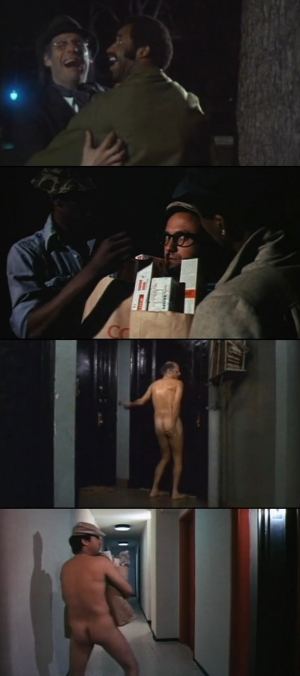 there’s thematic connections, and certain weird little scenes that you would be surprised happen very similarly in totally different movies. That’s one of the the things that I’ve been finding. After the subway video, I felt like the easiest way to really make the other ones more manageable would be to try to find those weird little connections. So, you would not think that there would be two movies where naked guys end up in the elevator. But it happens in two different movies, where they both get stripped by imposing Black males. Where’s Poppa? has Ron Leibman, who ends up in the park at night. He doesn’t have any money to give the gangs, so they tell him that he’s gotta run. Every time they catch him, they’re gonna take another article of clothing. Then the other one was Law and Disorder. That’s the scene where the guy’s got his groceries, and the two guys take him in the elevator. When he comes out, he’s got no more clothes. Anyway, stuff like that obviously speaks to the sort of overall craziness of the city at the time, which of course was exaggerated for the movies. There was a certain energy I wasn’t around for at the time. But when people comment on these kind of things, they usually characterize the city as being a lot more colorful and more unpredictable than it is now. And I think the films reflect that. Even though a lot of them are definitely amped up a little for dramatic effect.
there’s thematic connections, and certain weird little scenes that you would be surprised happen very similarly in totally different movies. That’s one of the the things that I’ve been finding. After the subway video, I felt like the easiest way to really make the other ones more manageable would be to try to find those weird little connections. So, you would not think that there would be two movies where naked guys end up in the elevator. But it happens in two different movies, where they both get stripped by imposing Black males. Where’s Poppa? has Ron Leibman, who ends up in the park at night. He doesn’t have any money to give the gangs, so they tell him that he’s gotta run. Every time they catch him, they’re gonna take another article of clothing. Then the other one was Law and Disorder. That’s the scene where the guy’s got his groceries, and the two guys take him in the elevator. When he comes out, he’s got no more clothes. Anyway, stuff like that obviously speaks to the sort of overall craziness of the city at the time, which of course was exaggerated for the movies. There was a certain energy I wasn’t around for at the time. But when people comment on these kind of things, they usually characterize the city as being a lot more colorful and more unpredictable than it is now. And I think the films reflect that. Even though a lot of them are definitely amped up a little for dramatic effect.
There’s probably more stuff that could be used in these videos. I like Trash. I feel like I’m not even as familiar or really versed in all of those Paul Morrissey films as I should be. I like the ones that I’ve seen. I look at them, for obvious reasons, as standing outside of a lot of the other films which are  more Hollywood, and produced by studios. That’s more of the stuff that’s in these videos. You know, they stand out for being more raw in a lot of different ways, and more envelope pushing. But of what I’ve seen, they’re very valuable. And I probably should have more of that in these videos, to be honest. Because I do think it’s an important voice. And it’s different, obviously, than something like Michael Winner and some of these other filmmakers that are not necessarily New Yorkers, or people that really “like” New York. I feel like even if Trash is showing some pretty unappealing things, unappealing characters, and showing a pretty seedy underbelly of the city, it feels more authentic. It’s certainly not trying to incite some kind of anti-New York feeling. Which I think when you’re watching Death Wish, it certainly seems like there’s a little of that — or a lot of that. I think a good way to put it would be the difference between an outsider making a New York film, versus someone who’s a native, or someone that’s lived there and is more familiar with it.
more Hollywood, and produced by studios. That’s more of the stuff that’s in these videos. You know, they stand out for being more raw in a lot of different ways, and more envelope pushing. But of what I’ve seen, they’re very valuable. And I probably should have more of that in these videos, to be honest. Because I do think it’s an important voice. And it’s different, obviously, than something like Michael Winner and some of these other filmmakers that are not necessarily New Yorkers, or people that really “like” New York. I feel like even if Trash is showing some pretty unappealing things, unappealing characters, and showing a pretty seedy underbelly of the city, it feels more authentic. It’s certainly not trying to incite some kind of anti-New York feeling. Which I think when you’re watching Death Wish, it certainly seems like there’s a little of that — or a lot of that. I think a good way to put it would be the difference between an outsider making a New York film, versus someone who’s a native, or someone that’s lived there and is more familiar with it.